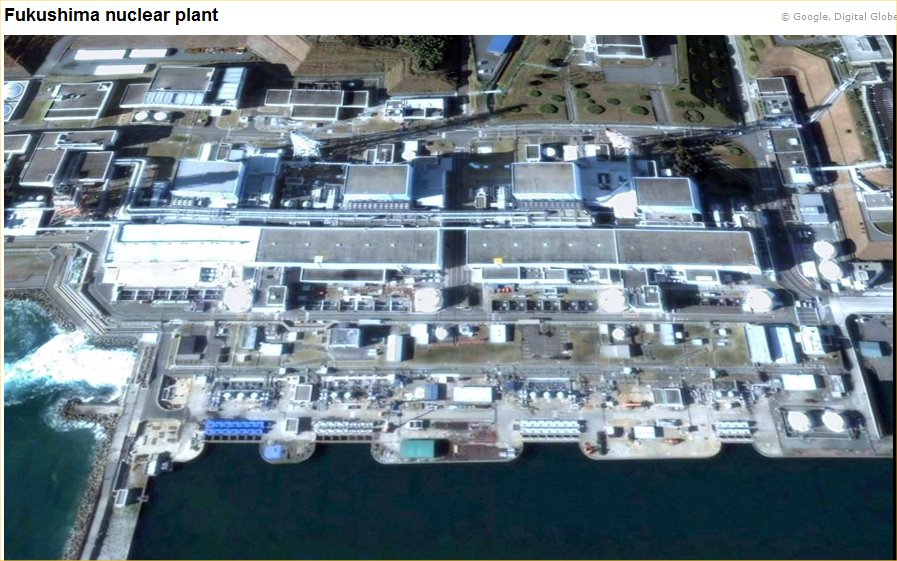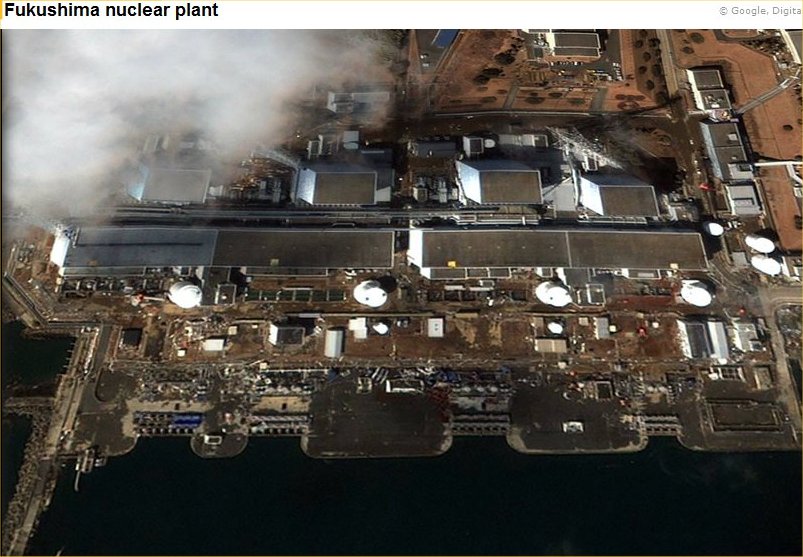|
 
March 21, 2011
The nuclear
power plants in Japan after the March 11 , 2011 earthquakes could become
a major nuclear disaster.
Keep watching this page for updates and insights by Raymond Rouse on the
issues from a nuke scientist's point of view.
Continuing
Updates:
IAEA
Status of Fukushima
INES
Leaflet on Nuclear Accidents
Continuing
Updates on Earthquakes around the world
IAEA Briefing on Fukushima Nuclear Accident (19 April 2011,
18.00 UTC)
Presentation:
Summary of Reactor Status
Fukushima Radiological Monitoring and Consequences
Fukushima Marine Environment Monitoring
On Tuesday, 19 April 2011, the IAEA provided the following information
on the current status of nuclear safety in Japan:
1. Current Situation
Overall, the situation at the Fukushima Daiichi nuclear power plant remains
very serious but there are early signs of recovery in some functions,
such as electrical power and instrumentation.
On 17 April, the Ministry of Economy, Trade and Industry (METI) announced
that TEPCO had issued a "Roadmap towards Restoration from the Accident
at the Fukushima Daiichi Nuclear Power Station". The roadmap outlines
63 measures to be taken in two steps over a period of six to nine months.
Changes to Fukushima Daiichi Nuclear Power Plant Status
The IAEA receives information from a variety of official Japanese sources
through the nation's national competent authority, the Nuclear and Industrial
Safety Agency. Additional detail is provided in the IEC status summary
with information received by 07:00 UTC on 19 April 2011.
TEPCO has provided a plan to NISA for the transfer of highly contaminated
water from the basement floor of the turbine building of Unit 2 to the
Main Building of the Radioactive Waste Treatment Facilities in order to
reduce the risk of this stagnant waste water being discharged to the environment.
On 17 and 18 April, an unmanned robot was used to conduct inspections
of the Reactor Buildings in Units 1, 2 and 3.
As of 18 April, white "smoke" was still observed coming from
Units 2, 3 and 4.
In Unit 1, fresh water is being continuously injected into the RPV through
the feed-water line at an indicated flow rate of 6 m3/h using a temporary
electric pump with off-site power. In Units 2 and 3, fresh water is being
continuously injected through the fire extinguisher lines at an indicated
rate of 7 m3/h using temporary electric pumps with off-site power.
RPV temperatures remain above cold shutdown conditions in all Units.
In Unit 1 the temperature at the feed water nozzle of the RPV is 170 °C
and at the bottom of the RPV is 115 °C. In Unit 2, the temperature
at the feed water nozzle of the RPV is 142 °C. In Unit 3 the temperature
at the feed water nozzle of the RPV is 100 °C and at the bottom of
the RPV is 114 °C.
In Unit 1 Nitrogen gas is being injected into the containment vessel
to reduce the possibility of hydrogen combustion within the containment
vessel. The pressure in this containment vessel has stabilised. The pressure
in the RPV is increasing. In Units 2 and 3 Reactor Pressure Vessel and
Drywell pressures remain at atmospheric pressure.
On 18 April the concrete pump truck sprayed water into the Unit 3 spent
fuel pool. On 17 April, approximately 140 tonnes of fresh water was pumped
into the Unit 4 spent fuel pool.
There has been no change in the status in Units 5 and 6 or in Common
Spent Fuel Storage Facility.
On 17 and 18 April, anti-scattering agent was sprayed over an additional
3100 m2 area near the Centralized Waste Treatment Facility.
2. Radiation Monitoring
On 18 April, deposition of I-131 was detected in 6 prefectures ranging
from 2.3 to 65 Bq/m2. Deposition of Cs-137 was detected in 2 prefectures;
the values reported were 4.7 and 14.8 Bq/m2.
Gamma dose rates are measured daily in all 47 prefectures. The values
tend to decrease over time. For Fukushima, on 18 April a dose rate of
1.9 µSv/h was reported. In the Ibaraki prefecture, a gamma dose
rate of 0.13 µSv/h was reported; in all other prefectures, reported
gamma dose rates were below 0.1 µSv/h.
Dose rates are also reported specifically for the Eastern part of the
Fukushima prefecture, for distances beyond 30 km from Fukushima-Daiichi.
On 17 April, the values in this area ranged from 0.1 to 23 µSv/h.
MEXT has set up an additional monitoring programme in cooperation with
local universities. For 18 April, measurements of the gamma dose rates
were reported for 53 cities in 40 prefectures. In Fukushima City, a value
of 0.38 µSv/h was observed; in 9 cities, gamma dose rates ranged
from 0.13 to 0.17 µSv/h. For the other cities, gamma dose rates
of less than 0.1 µSv/h were reported.
In drinking water, I-131 or Cs-137 is detectable at very low levels only
in a few prefectures. As of 17 April, one restriction for infants related
to I-131 (100 Bq/l) is in place in a small scale water supply in a village
of the Fukushima prefecture.
On 18 April, the IAEA Team made measurements at 12 different locations
in the Fukushima area at distances ranging from 13 to 43 km, South and
Southwest from the Fukushima nuclear power plant. At these locations,
the dose rates ranged from 0.25 to 6.8 µSv/h. At the same locations,
results of beta-gamma contamination measurements ranged from 0.01 to 0.15
Megabecquerel/m2.
Analytical results related to food contamination were reported by the
Japanese Ministry of Health, Labour and Welfare on 18 April, and covered
a total of 23 samples taken on 8, 15, 17 and 18 April. Analytical results
for all of the samples of various vegetables, shiitake mushrooms, leafy
vegetables, fruit (strawberries), fish and unprocessed raw milk in eight
prefectures (Chiba, Fukushima, Gunma, Hokkaido, Ibaraki, Niigata, Saitama
and Yamagata) indicated that I-131, Cs-134 and/or Cs-137 were either not
detected or were below the regulation values set by the Japanese authorities.
UPDATE AS OF 5 P.M. EDT, MONDAY, APRIL 18:
Tokyo Electric Power Co. (TEPCO) estimates it will take up to nine months
to stabilize the Fukushima Daiichi nuclear power plant. A plan released
Sunday breaks the project into two steps, the first taking up to three
months, the second up to six months more.
According to the company’s “Roadmap Towards
Restoration,” TEPCO plans to:
Fill the containment vessels of reactors
1 and 3 with enough water to cover the fuel in the reactors while it decides
the best course of action to repair the damaged containment vessel of
reactor 2. The goal is to lower the temperature of the water inside the
reactors to below boiling.
Install heat exchangers to help cool the reactors. TEPCO continues to
inject water into the reactors to prevent overheating. TEPCO also continues
to spray water onto the used fuel storage pools as needed.
Use giant covers with filters to enclose the reactor buildings and control
the release of radioactivity.
Install additional water storage tanks and purification facilities to
process the highly radioactive water that has accumulated in the plant
buildings and nearby concrete enclosures. The decontaminated water then
will be used to cool the reactors. Radioactive water that has accumulated
in turbine room basements is hampering work to restore cooling operations.
Expand monitoring of radiation in the 12.5-mile evacuation area and later
decontaminate houses and soil.
TEPCO continues injection of nitrogen gas
into the containment vessel of reactor 1 to stabilize the environment
inside the reactor.
New Videos Posted
NEI has uploaded two new videos to its YouTube channel: "Health Physicist
Explains the Differences in Health Impacts From Fukushima Versus Chernobyl"
and "Health Physicist Says Fukushima Poses No Health Risk to Americans."
Both videos feature Barbara Hamrick, radiation safety officer and certified
health physicist at the University of California's Irvine Medical Center.
|

